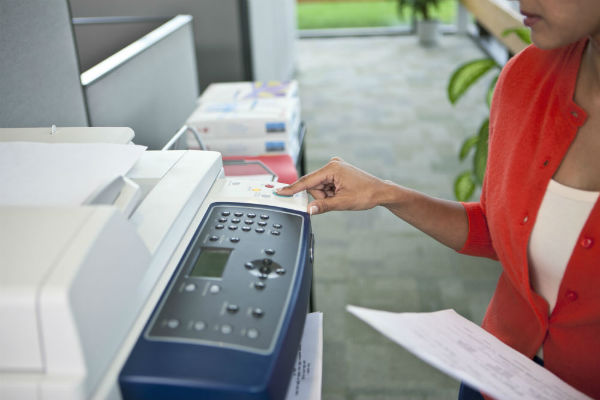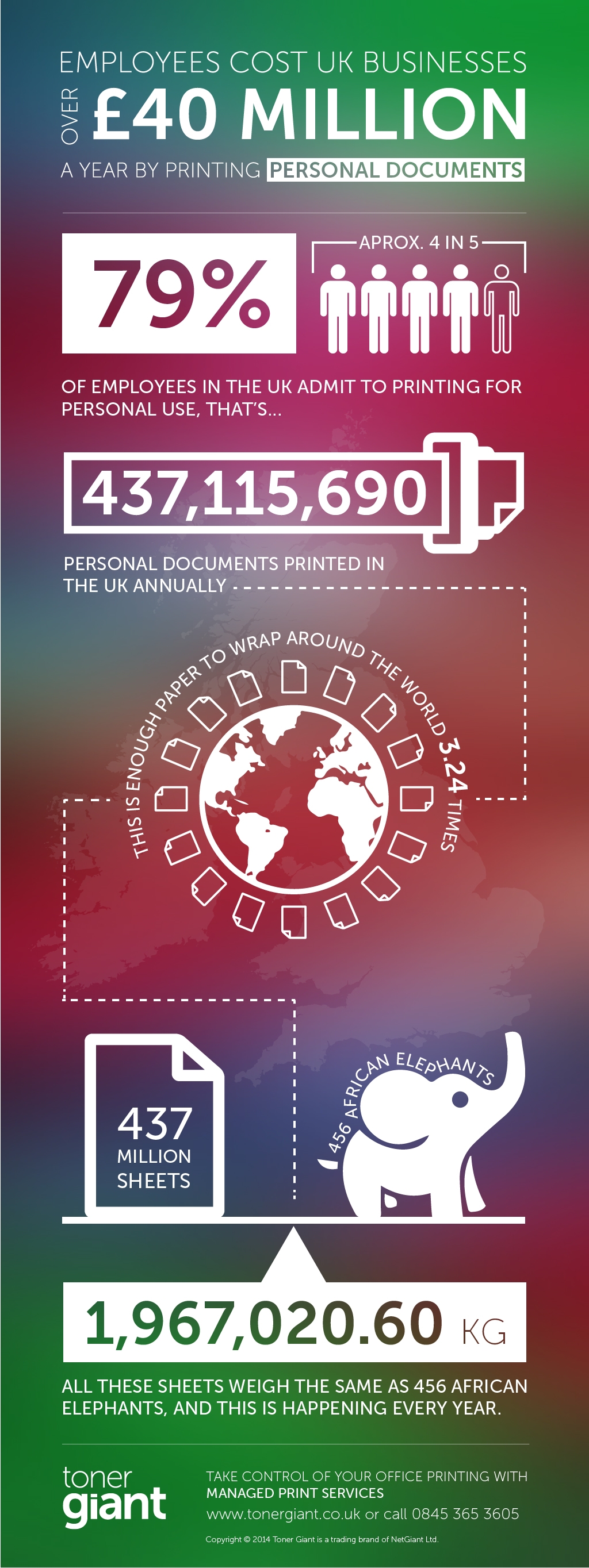We’ve all done it, haven’t we?
(Of course, if my boss is reading, I most definitely haven’t, ever! Scout’s honour!)
Whether it’s because we’ve not got a printer at home, or it costs too much, or it’s just a helluva lot more convenient- there’s a good chance that, at some point in our working lives, we’ve all used the office printer to sneakily print off a personal document.

An email from a friend. Directions to that place you’re travelling to at the weekend. Gig tickets. All these are examples are the kind of things some people might print off when they get a spare five minutes at work, fold it up, and take it home with them at the end of the day.
What’s the harm, right? Well, that’s probably an argument best left between an employee, an employee’s conscience, and their employer! But what we’ve worked out at TonerGiant is that printing personal documents at work are costing UK private sector businesses upwards of £40 million each year!
Seriously?
Yep! You can see our full list of calculations in this PDF, but to give you a snapshot of what we’ve discovered:
- Employees printing their personal documents at work costs UK private sector businesses as a whole £40,083,508.77 annually
- Approximately 4 out of 5 employees are open about the fact that they use the office printer for their own personal documents, with 9% of these people admitting that they do this at least once a day
- 15% of employees even admit they’ve used their work’s printer to print off CVs for job hunts!
- 437,115,679 personal documents are printed annually in the UK- that’s enough paper to wrap around the world 3.24 times!

And what’s more, that £40 million figure is likely to be a lot lower than the actual amount! That’s because we’ve not accounted for those people in the research we based our calculations on that didn’t admit to doing shifty personal printing at work, and those that may do it more than once a day! Not to mention the wear and tear effect and resulting maintenance of office printers and the costs that these incur.
Check out our infographic.
Not the only area of concern…
Employees printing off that Nigella recipe to take home for their tea, or their budget airline boarding passes for their holiday (which I’ve personally witnessed at a previous workplace), are just examples of a number of ways in which businesses appear to be losing control of their printing.
An alarming 69% of organisations don’t actually know how much their printing costs them! So apart from personal printing, where does all that money go and why?
- Ink and toner: Of course, all printing will inevitably drain ink and toner supplies. But it’s more frustrating knowing that a significant amount of those supplies are being used on things like employees’ personal documents. 39% of companies admit that ink and toner costs are the hardest to measure.
- Paper waste: Those personal documents are just a drop in the ocean in terms of needless paper usage. Around two-thirds of all paper is wasted, with something as simple as not printing on both sides of the page attributing to around 19% of this.
- Downtime and maintenance: Running out of ink and toner, paper jams, error messages, etc creates downtime. Ultimately, this impacts productivity as a result of lost time. And then after that, sorting out these problems takes up the time of your IT department- around 80% of IT managers believe that the efficiency of their company printing could be improved.
In short, printing is causing headaches for finance directors up and down the country.
What you can do…
There are ways you can prevent your office printer from hemorrhaging more money than a badly thought out task on The Apprentice, both in terms of combating the amount you spend on printing your employees’ personal documents for them, and other types of printing expenditure.
- Draw up a written company printing policy: Like we said earlier, the ethics around whether it’s ok to print the odd personal document off at work is something that should really be sorted between employee and employer! But a company printing policy should help make things a little clearer. If you don’t want your employees printing off non-work related things, tell them in your policy. If you want to put a limit on how much they can use, outline what you constitute as being a reasonable amount each week/month.
- Keep track of how much personal printing is going on: This could be as simple as leaving a sheet next to your printer that employees must use to note what they’re printing and when. Of course, something like this needs a large degree of honesty involved, but let’s assume your workers are fair people!
- Invest in new printer technology: Many new printers on the market today come equipped with software that keeps track of what’s being printed, by whom, and when. You can also control what’s allowed to be printed and what isn’t. Furthermore, a new printer will also be more efficient (saving you money in terms of energy) and more reliable (reducing downtime).
- Think greener: Are your printers set to duplex (double-sided) as the default? This is a really quick way of ensuring that everyone is thinking about using both sides of the page. In addition, make sure everyone in the office is tuned into the idea of trying to save paper.
- Consider a managed print solution: From simple tools that monitor your ink and toner levels to a service that takes care of absolutely everything to do with the running and maintenance of your office printers, a managed print solution could cut your costs by as much as 30%, according to Oki.
Like this infographic? Why not embed it onto your site or blog? Simply copy & paste the embed code below:
<a class=”embedly-card” href=”https://blog.tonergiant.co.uk/wp-content/uploads/2014/10/Cost-of-personal-print-infographic.jpg”>null</a>
<script async src=”//cdn.embedly.com/widgets/platform.js” charset=”UTF-8″></script>

